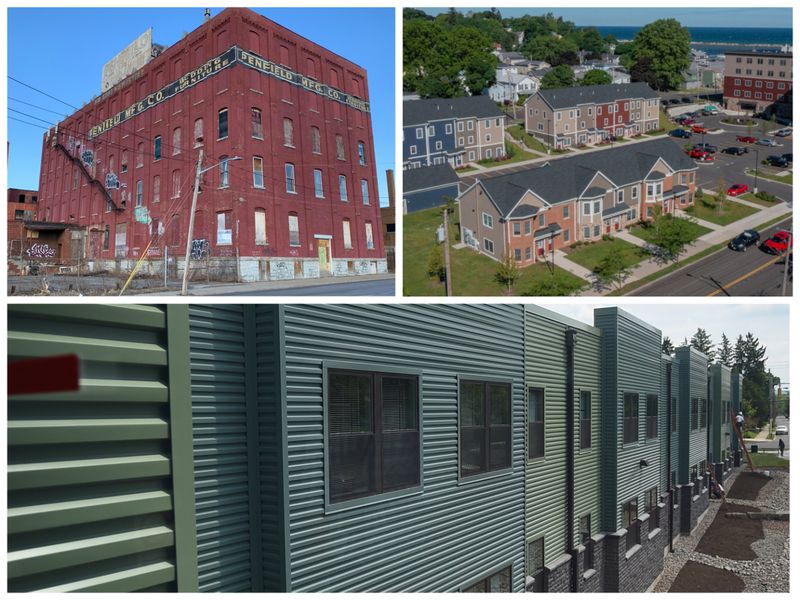Gov. Kathy Hochul has made addressing New York’s affordable housing crisis a cornerstone of her agenda. Her New York Housing Compact would encourage construction of 800,000 new homes over the next decade through a combination of state incentives, relaxed zoning codes and growth targets for every community.
It’s a controversial plan. To examine its implications and stimulate community discussion, today we launch a series of conversations with stakeholders in the affordable housing arena, beginning with Ben Lockwood.
Lockwood is president and CEO of Housing Visions, a not-for-profit developer based in Syracuse. Over the past 30 years, the agency has developed a $466 million portfolio of 409 buildings with 1,820 units across Upstate New York and Pennsylvania. Its projects include VanKeuren Square on East Genesee Street, the Penfield Manufacturing building near Washington Square, and Harbor View Square in Oswego.
Lockwood was appointed CEO of Housing Visions in March 2019. He holds a degree in urban and regional studies from Cornell University. Our conversation has been edited for clarity and length.
Q: You’re not sold on the governor’s “stick” approach to building more housing — the threat that the state would override local zoning law if a community fails to meet a growth target of 1% every three years. What would be a better approach?
A: I do think the policy is well-intentioned. Maybe it’s a step ahead of where some of the local communities are … [they] recognize the need that’s out there. I typically [believe] the carrot is better than the stick. From a policy perspective, do I know exactly what the carrot should be? No. But I think just being factual in towns and suburbs is important. In Onondaga County and across Upstate New York, we have a rapidly aging populace. We have a lot of people that are “over-housed” — boomers who don’t have children at home, and yet they still have that three- or four-bedroom houses that they raised their family in. What are their options if they want to remain in some of these great places we have in Central New York? … We need options for people to remain in communities that they’ve grown and loved, where they’ve lived and aged, and want to be able to stay there.
Things are about to take off in Central New York, and that’s both exciting and scary.
Q: It’s tremendously expensive to build affordable housing — upward of $300,000 a unit. Why does it cost so much?
Q: Can it be done more cheaply?
Q: Is the problem with housing in Syracuse quantity, quality or both?
Looking at Micron, gosh, is it going to be both quantity and quality now?
A: We use a program called the Low-Income Housing Tax Credit. In any given year, it is oversubscribed in New York state by 6-1 or 7-1. So an expansion of the credit would be good.
… [If there was one thing I’d ask for,] it’s an expansion of the resources from the federal government. I do believe that New York state is doing a lot. Onondaga County, with the new funds that the county exec announced, I think that’s good. In my perfect world, I would want a dedicated funding source on an annual basis, because our housing problems are only going to be exacerbated here in the coming years.
A: Any place that has exclusively single-family zoning, or no zoning where you could actually add multifamily housing, that’s absolutely a problem. I don’t think that’s a controversial statement. Say if your community only allows single-family housing on 1-acre plots, you’re going to get single family housing on 1-acre plots, and you’re not going to get kind of the missing middle or any range other than what’s been there.
Q: Half of Onondaga County renters are considered “rent-burdened” — that is, they spend 30% of their income on housing. Are rents too high or are wages too low?
Q: What’s your biggest project to date?
And then we look across the street, where somebody has purchased two more buildings that were part of that complex. And some for-profit developers who have purchased across the street plan to do 40 or 50 units of market- or near-market-rate housing. That is a good testament to the work that we’re doing there — in other people seeing, OK, I’ll throw my money in. That’s where affordable housing can be a force for good. We’re “first money in,” stabilizing things or showing people that this is worthwhile to invest in. I think that’s an exciting thing.
A: I’m excited for Central New York and Syracuse. What’s about to happen here is just a new era of growth and things that we have not experienced, really, ever. We have either been decline or stagnation or teeny bit of growth. What happens when Micron breaks ground and shows up and starts producing chips? That’s an exciting prospect.
